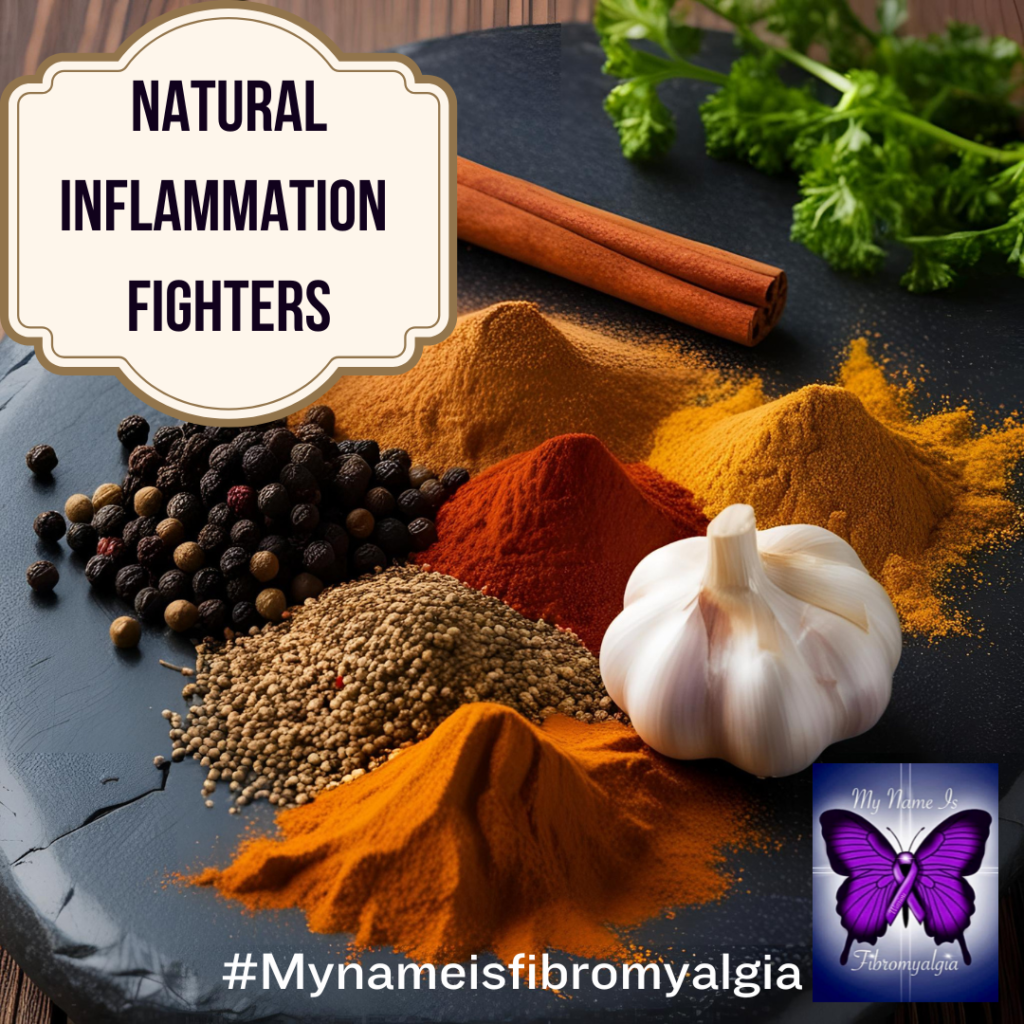Natural Inflammation Fighters – Found In Your Spice Cabinet.

Finding Relief in the Spice Cabinet: A Guide to Natural Inflammation Fighters for Pain Patients
Chronic pain can be a relentless adversary, impacting every aspect of life. For many, the search for relief is a journey filled with medications and therapies. However, there’s a powerful ally often overlooked: the humble spice cabinet.
Nature has gifted us with a diverse array of spices. That possesses potent anti-inflammatory properties, offering a natural and supportive approach to managing pain.
This guide delves into the world of inflammation-fighting spices, providing information and support for pain patients seeking to explore these natural remedies. Remember, while these spices can be incredibly beneficial, they should complement, not replace, professional medical advice and treatment.
Understanding Inflammation and Pain
Before we explore the spices, it’s crucial to understand the connection between inflammation and pain. Inflammation is the body’s natural defense mechanism, a response to injury or infection. However, chronic inflammation, where the body’s immune system is constantly activated, can lead to persistent pain and discomfort. This type of inflammation is often associated with conditions like arthritis, fibromyalgia, and inflammatory bowel disease.
Spices, rich in bioactive compounds, can help modulate the inflammatory response, offering a natural way to manage pain and improve quality of life.
The Powerhouse Spices: A Deep Dive.
Let’s explore some of the most potent anti-inflammatory spices and how they can benefit pain patients:
Turmeric: The Golden Healer.
Turmeric’s vibrant yellow hue comes from curcumin, its primary active compound. Curcumin is a powerful anti-inflammatory and antioxidant. It’s studied extensively for its pain-relieving properties and effects.
How it helps: Curcumin works by inhibiting several inflammatory pathways in the body, reducing the production of pro-inflammatory cytokines. Studies suggest it may be effective in managing pain. That is associated with osteoarthritis, rheumatoid arthritis, and other inflammatory conditions.
Maximizing benefits: Curcumin’s bioavailability is low, meaning the body doesn’t absorb it very easily. To enhance absorption, combine turmeric with black pepper, which contains piperine. Consider using turmeric in curries, soups, and smoothies or taking a high-quality supplement.
Support for pain patients. Turmeric offers a gentle and natural approach to pain management, helping to reduce inflammation and improve mobility.
Ginger: The Soothing Root
Ginger’s warm and pungent flavor is a staple in many cuisines and a potent anti-inflammatory agent.
How it helps: Ginger contains gingerol, a compound that inhibits the production of inflammatory prostaglandins. It can help alleviate pain associated with muscle soreness, osteoarthritis, and menstrual cramps.
Versatile use. Ginger can be used fresh, dried, or powdered. Add it to teas, stir-fries, soups, or smoothies. Ginger essential oil can be used for pain relief.
Support for pain patients. Ginger provides a soothing effect, helping to ease pain and reduce discomfort.
Cinnamon: The Sweet Anti-Inflammatory
Cinnamon is more than just a delicious spice. It also possesses significant anti-inflammatory properties.
How it helps: Cinnamon contains cinnamaldehyde, a compound that inhibits the production of inflammatory mediators. It may help reduce pain associated with arthritis and other inflammatory conditions.
It helps by regulating blood sugar and reducing inflammation.
Easy incorporation: Sprinkle cinnamon on oatmeal, yogurt, or toast. Add it to baked goods, curries, or teas.
Support for pain patients: Cinnamon offers a comforting and flavorful way to manage pain and improve overall well-being.
Garlic: The Immune Booster
Garlic, with its pungent flavor and aroma, is a culinary staple and a potent anti-inflammatory and immune-boosting agent.
How it helps: Garlic contains allicin, a compound that inhibits the production of inflammatory cytokines. It can help reduce pain and inflammation associated with arthritis and other inflammatory conditions.
Culinary versatility: Garlic could be added to countless dishes, from stir-fries and soups to sauces and dressings.
Support for pain patients: Garlic’s immune-boosting properties can help strengthen the body’s defenses and reduce inflammation.
Black Pepper: The Absorption Enhancer
While often paired with turmeric, black pepper itself has anti-inflammatory properties thanks to the compound piperine.
How it helps: Piperine inhibits inflammatory enzymes and enhances the absorption of other beneficial compounds, particularly curcumin.
Simple addition: Add black pepper to your meals to enhance flavor and boost the absorption of other anti-inflammatory spices.
Support for pain patients: Black pepper plays a vital role in maximizing the benefits of other pain-relieving spices.
Cayenne Pepper: The Pain Reliever
Cayenne pepper’s fiery heat comes from capsaicin, a compound that can help relieve pain.
How it helps: Capsaicin works by depleting substances and neurotransmitters involved in pain signaling. It could provide relief from pain associated with arthritis, neuropathy, and muscle soreness.
Cautious use: Cayenne pepper can be potent, so start with small amounts and gradually increase as tolerated. Topical creams containing capsaicin are also available.
Support for pain patients: Cayenne pepper offers a powerful and targeted approach to pain relief.
Rosemary: The Aromatic Anti-Inflammatory
Rosemary, with its fragrant aroma, is a culinary herb and a potent anti-inflammatory agent.
How it helps: Rosemary contains rosmarinic acid, a compound that inhibits the production of inflammatory mediators. It can help reduce pain and inflammation associated with arthritis and other inflammatory conditions.
Versatile use: Rosemary can be used fresh or dried in various dishes, from roasted vegetables and meats to soups and stews. Rosemary essential oil could be used for pain relief.
Support for pain patients: Rosemary offers a calming and aromatic way to manage pain and improve overall well-being.
Incorporating Spices into Your Pain Management Plan
Start slowly: Introduce new spices gradually to assess your tolerance and identify any potential allergies.
Combine spices: Synergistic effects could be achieved by combining different spices. For instance turmeric and black pepper.
Use fresh spices whenever possible: Fresh spices tend to have a higher concentration of beneficial compounds.
Explore different preparations: Experiment with using spices in various forms, such as teas, infusions, and topical applications.
Maintain a balanced diet: Spices are most effective when combined with a healthy and balanced diet rich in fruits, vegetables, and whole grains.
Consult with a healthcare professional: Discuss your pain management plan with your doctor or a registered dietitian to ensure that the spices are compatible with your medications and overall health.
A Supportive Approach
Chronic pain can be a challenging journey, but you are not alone. By incorporating these inflammation-fighting spices into your daily routine, you can take a proactive step towards managing your pain and improving your quality of life. Remember to listen to your body, be patient, and seek professional guidance when needed.
This information is for educational purposes only and should not be considered medical advice. Always consult a qualified healthcare professional before you make any changes to your diet or treatment plan.
THE LINKS TO OUR RESEARCH.








